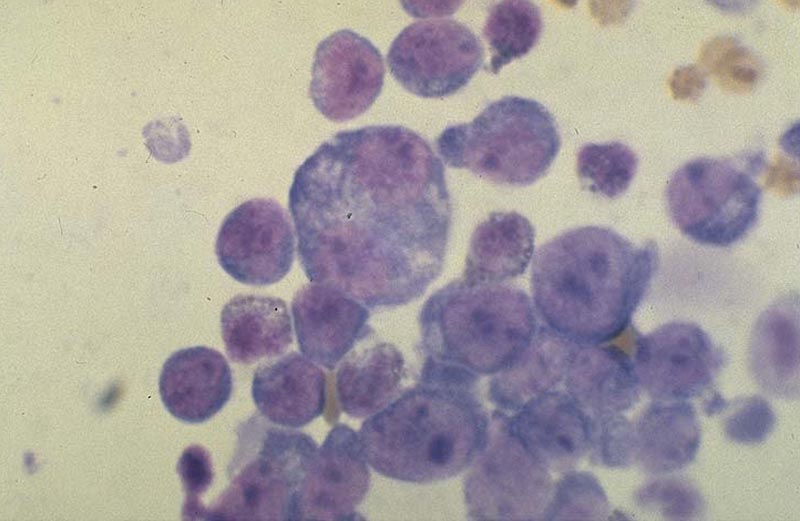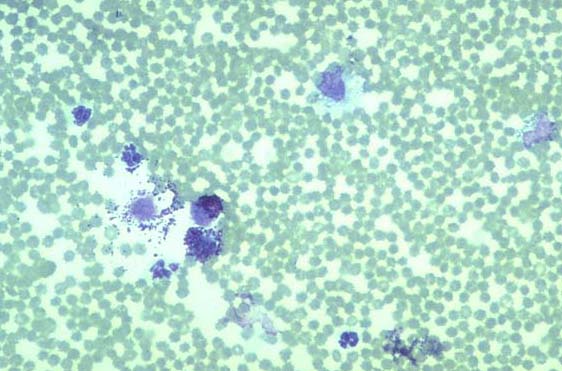canis - Articles
Peritoneal fluid: cytology
Overview
- Peritoneal fluid occurs within the abdominal/peritoneal cavity. Very little or no fluid can be aspirated unless effusion is present.
- Normal fluid is clear and colorless to slightly yellow, and is of low cellularity (<1000 nucleated cells/ml) and protein (<2.5 g/dl).
- Four mechanisms result in cavity effusions:
- Transudate - low specific gravity fluid crosses membrane barrier.
- Exudate - inflammation allows fluid with high cellular and protein component to cross vessel walls.
- Vessel or viscous rupture.
- Neoplastic proliferation.
- Cell characteristics vary in septic conditions and with neoplasia.
- Cytology enables finer differentiation of type of abdominal effusion Effusion: overview.
Uses
Alone
- Differentiate transudate from modified transudate or exudate.
- Differentiate septic from non-septic exudate.
- Diagnosis of lymphoma
 Lymphoma or mast cell tumor
Lymphoma or mast cell tumor  when neoplastic cells are exfoliated into the effusion.
when neoplastic cells are exfoliated into the effusion.
In combination
- With other laboratory measures to diagnose cause of abdominal effusion, in particular to identify those due to infections or malignancy.
Other points
- Many tumors result in an effusion due to associated inflammation, eg with a necrotic tumor, or due to increased hydrostatic pressure but the tumor cells are not necessarilyexfoliated into the effusion.
Sampling
Subscribe To View
This article is available to subscribers.
Try a free trial today or contact us for more information.
Tests
Methodologies
- Centrifuge fluid at 1000 rpm for 10 min.
- Pour off supernatant and resuspend sediment by flicking tube.
- Put drop onto slide and make smear as for blood smear.
- Or use cytospin centrifuge.
- Air dry slide.
- Stain with Giemsa.
Availability
- Widely available at commercial laboratories.
- Smears can be examined in practice.
Validity
Sensitivity
- As with any cytologic specimen absence of evidence does not provide conclusive support for absence of a particular condition.
Specificity
- As with any cytologic specimen absence of evidence does not provide conclusive support for absence of a particular condition.
Technique intrinsic limitations
- Cytologic evaluation may be compromised by excessive blood contamination.
Technician extrinsic limitations
- May be difficult to differentiate reactive mesothelial cells from some neoplastic cells, eg carcinoma/adenocarcinoma/mesothelioma.
Result Data
Subscribe To View
This article is available to subscribers.
Try a free trial today or contact us for more information.
Further Reading
Publications
Refereed papers
- Recent references from VetMedResource and PubMed.
- Dunn J K & Villiers E (1998) Cytological and biochemical assessment of pleural and peritoneal effusions. In Pract 20, 501-505.
- Steyn P F & Wittum T E (1993) Radiographic epidiemiologic and clinical aspects of simultaneous pleural and peritoneal effusions in dogs and cats - 48 cases (1982-1991). JAAHA 202, 307-312.
- Wadle J R & Giger U (1990) Lipoprotein electrophoresis differentiation of chylous and nonchylous pleural effusions in dogs and cats and its correlation with pleural effusion triglycerole concentration. Comp Cont Ed Pract Vet 10, 121-136.
- Meyer D J & Franks P T (1987) Effusion - classification and cytologic examination. Comp Cont Ed Pract Vet 9, 123-128.
Other sources of information
- Cowell R L, Tyler R D & Meinkoth J H (1999) Diagnostic Cytology and Hematology of the Dog and Cat. 2nd edn. Mosby, USA.
- Duncan J R, Prasse K W & Mahaffey E A (1994) Veterinary Laboratory Medicine. Clinical Pathology. 3rd edn. Iowa University Press, USA.